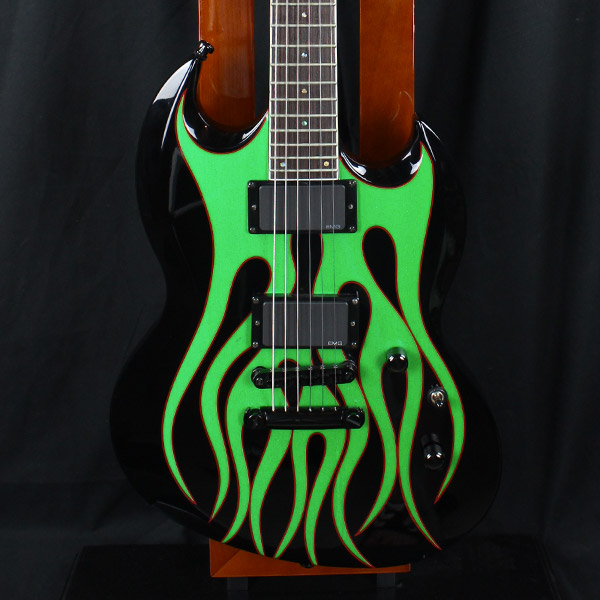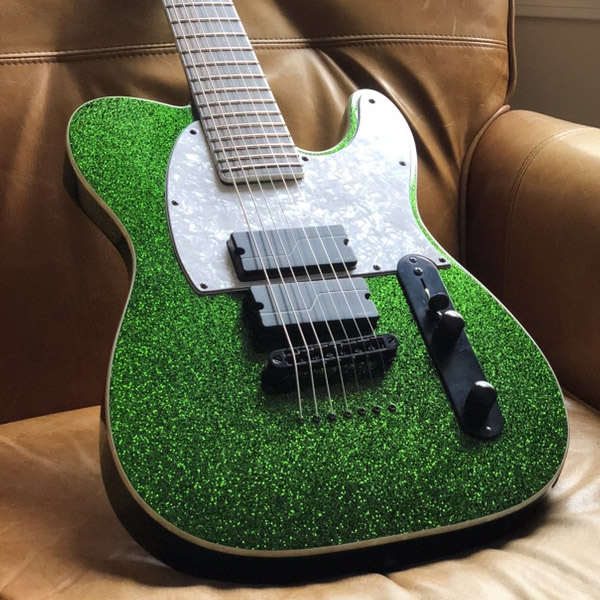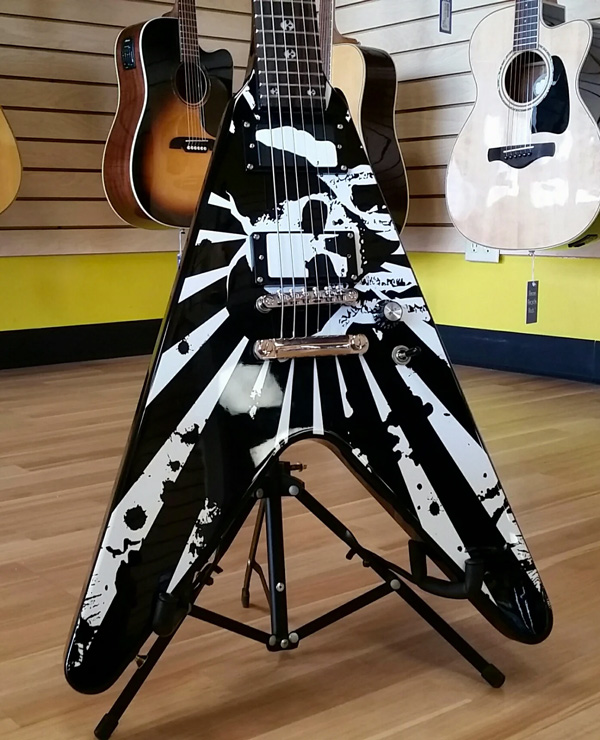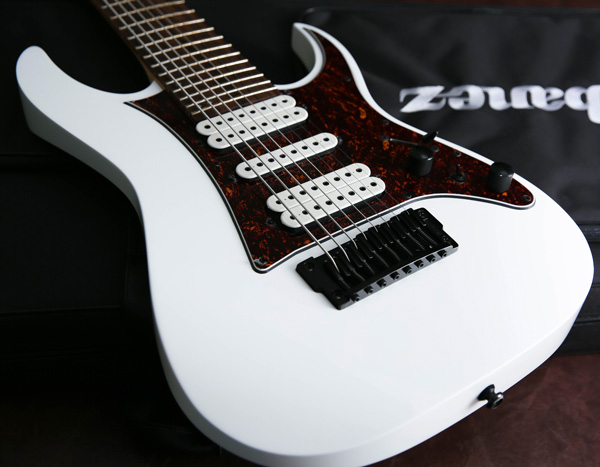The baritone guitar gets no love.
To some, the "missing link" between a regular guitar and a bass is nothing more than fodder for a Duane Eddy-inspired spaghetti western soundtrack. To others, the downtuned qualities of a baritone guitar may conjure up memories of various 1980s radio staples that span from The B-52s' "Rock Lobster" to The Cure's entire Disintegration album in 1989.
In the world of metal music—where tuning down to B, A, or lower has been standard practice for three decades—the baritone guitar's ground-shaking influence can be felt, even as it has taken a slightly less-traveled path than other extended-range instruments. While not as popular as its 7- and 8-string counterparts, the baritone guitar's influence—especially on modern-day rock guitarists and metal genres—cannot be overlooked.
Why Go Baritone?
Plenty of metal bands with a taste for downtuning have opted to employ Fender (25.5") and Gibson (24.75") scale guitars over the years. But for guitarists accustomed to light strings—such as .09 and .10 gauge string sets—attempting to tune down can quickly lead to muddiness, tuning instability, and a completely different feel, due to the lack of string tension between the bridge and nut.
To compensate for the lack of string tension on a downtuned standard-scale guitar, guitarists most often use thicker strings ranging from .011 for a guitar turned to D or .012 or .013s for lower tunings. Sets of strings designed for this purpose often will also come with a wound G string to combat intonation issues and provide a clear, deep sound necessary for lower tunings.
Baritone guitars offer a different solution. With many guitarists preferring the feel and attack of lighter strings, baritone guitars bridge the gap between guitar and bass by increasing the scale length—the distance between bridge and nut—of a guitar. Specifically designed for tunings well below E standard, baritone guitars offer a mix of adequate string tension, clarity, and comfort—and they feature scale lengths ranging between 26.5" (a full inch longer than a Fender Stratocaster) and around 30".
Baritone Guitar in Metal
The 1980s were a decade marked by landmark albums and musical trends within metal. The new wave of British heavy metal. Thrash. Power metal and progressive metal. But by the end of the decade—a couple years before Kurt Cobain would put an abrupt end to metal's mainstream, glam-driven popularity—new trends began to emerge within metal's more extreme subgenres. Thanks to the likes of guitarists Bill Steer of Carcass and Bolt Thrower's duo of Gavin Ward and Barry Thompson, death metal's downtuned descent would fully begin in 1989 on albums such as the latter's Realm of Chaos, which featured 6-string guitars tuned to A standard.
With downtuning quickly becoming popular, plenty of guitarists would opt for thicker strings on regular-scale instruments, while others—such as Morbid Angel's Trey Azagthoth—would popularize the 7-string guitar as early as 1993. The 6-string baritone guitar would soon find its place as well. Machine Head's Robb Flynn collaborated with Epiphone on a signature baritone model, the Love/Death Baritone Flying V while others, such as At The Gates' Martin Larsson, recently collaborated with Ola Englund's Solar Guitars on a custom baritone model.
Nu-Metal and the "7-String Baritone"
Korn's "Blind" was released 25 years ago this August, and with it, a new genre emerged: nu-metal.
Yes, Brian "Head" Welch and James "Munky" Shaffer are well-known to use Ibanez 7-string guitars. However, the influence of the band's downtuned guitar riffs would leave countless guitarists looking for ways to effectively tune down. Some guitarists, like Sevendust's Clint Lowry, opted to take guitars such as an Epiphone Les Paul and tune to drop B or Bb. Others—such as Staind's Mike Mushok and Chevelle's Pete Loeffler—would opt to write music exclusively on baritone guitars, giving 2000s radio rock a distinctive sound unto itself.
Speaking of the 2000s, it's worth noting that even the likes of Metallica's James Hetfield jumped on the baritone guitar trend, albeit briefly, on the band's infamous (or, arguably, underrated) 2003 album, St. Anger. While most of the album's repetitive, cyclical guitar riffs stay in drop C guitar tuning, James Hetfield was able to tune down to Ab for "Invisible Kid," courtesy of a custom-built, baritone ESP Viper known as The Grynch.
Extended-scale guitars aren't just limited to six strings. Within the last 15 years, numerous metal-oriented guitar manufacturers, such as ESP and Schecter, have popularized the 7-string baritone guitar, featuring both an extra string and the extended scale length. This combination in particular found an early adopter in Deftones' Stephen Carpenter, who began tuning down his ESP signature models to G# (low to high: G#-C#-F#-B-E-G#-C#) as early as the band's self-titled 2003 record and dropping down to F# on Saturday Night Wrist in 2006.
Seven-string baritone guitars would quickly find popularity across many of metal's subgenres. Fear Factory's Dino Cazares has tuned his 7-string guitars to A standard since the band's 1998 album Obsolete, and is currently endorsed by Australia's Ormsby Guitars. Devin Townsend of Strapping Young Lad would take a different approach, using the extended scale—and extra string—to tune to open C (low to high: G-C-G-C-G-C-E) or its neighbor a half-step lower, open B.


Extended-Range Instruments Today
Thanks to the likes of Animals As Leaders and Meshuggah—and countless F#-tuned bands fixated on odd-meter guitar riffs—the demand for extended-range instruments has blown up over the last decade.
Similar to how the likes of Duane Eddy and Glen Campbell brought notoriety to the baritone guitar in country music during the 1960s, Tosin Abasi, as well as Meshuggah's Fredrik Thordendal and Mårten Hagström, have used the 8-string guitar to redefine and reshape the sound of metal over the past decade—and in Meshuggah's case, much longer.
By way of technicality, too, the 8-string guitar falls within the realm of baritone guitars. That's because to achieve both clarity and adequate string tension with low tunings, where the line between guitar and bass is blurred, 8-string guitars typically are accompanied by scale lengths ranging from 27" to 29" to accommodate string sets from a .010 for the high E to a .085 for the low F#.
As such, guitar manufacturers quickly followed suit, with Ibanez releasing the first mass-produced 8-string guitar, the RG2228, as far back as 2007.
Currently, the likes of Ibanez, Schecter, and Jackson led the way in introducing extended-range instruments to new audiences on a budget while others, such as Keisel and Strandberg, take a different—and more expensive—approach with "multiscale" instruments that provide baritone-level string tension on the low strings and more familiar, Fender-level string tension at the high E.


